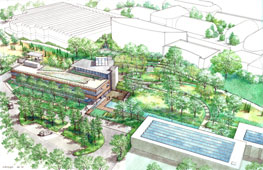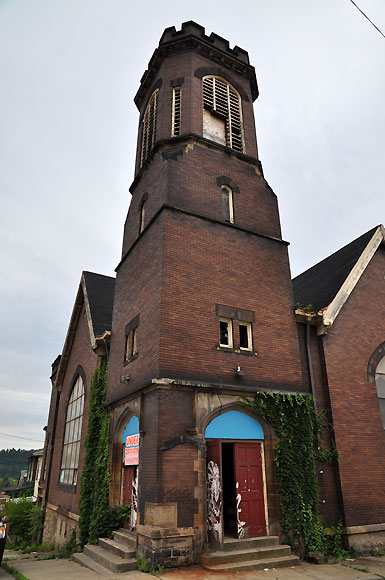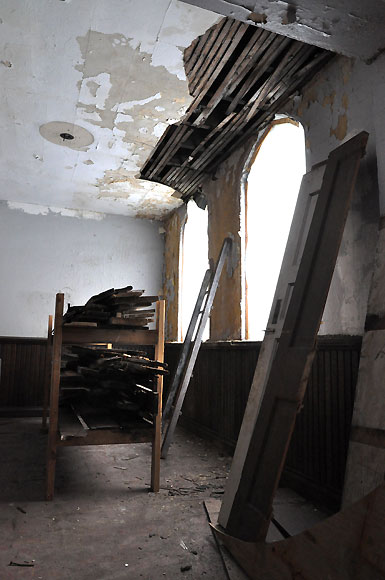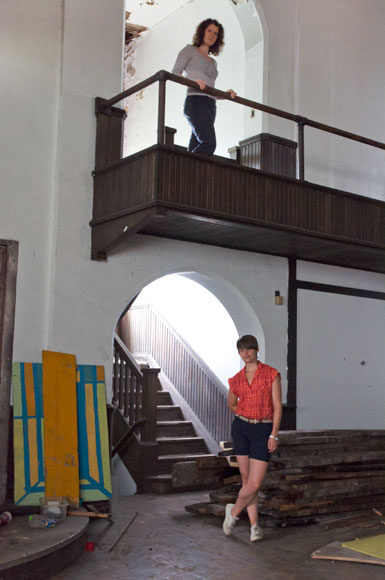
Category Archive: Education
-
Phipps’ Center for Sustainable Landscapes Chosen to Test New Green Design Rating System
Pop City Media
Wednesday, June 16, 2010
Phipps Conservatory and Botanical Garden’s Center for Sustainable Landscapes, which is in its final phase of design, has been selected to join 175 other pilot programs to test a revolutionary new rating system for green landscape design called The Sustainable Sites Initiative, or SITES.

SITES is similar to the LEED building rating system, only for landscapes, and is set to become the international standard for eco-friendly landscape practices. The Center for Sustainable Landscapes was asked to join the testing program, because of the new building’s impressive list of sustainable features.
The $20 million Center for Sustainable Landscapes, a research and educational institution, will be a Living Building, going far beyond LEED certification, by generating all of its own energy with renewable resources, and capturing all water on site. It features a green roof, rain gardens, permeable paving, locally harvested and salvaged materials, and a wetland and lagoon system. Landscape practices at the building will include protecting and restoring soil conditions, native plant landscaping and ecosystem restoration, and revolutionary energy efficiency.
“The opportunity to combine cutting edge building technology with the highest standards of sustainable landscape design will allow Phipps to present a complete picture of how important it is to sensitively integrate our buildings into the environment and how important plants are to our lives,” says Phipps’ Director Richard Piacentini.
The pilot phase for SITES is scheduled to run through June 2012, and feedback from The Center for Sustainable Landscapes as it nears the end of its design phase and enters construction, will help SITES finalize their rating system by 2013.
Sign up to receive Pop City each week.
Writer: John Farley
Sources: Liz Fetchin, Communications Director for Phipps Conservatory
Richard Piacentini, Director of Phipps ConservatoryImage courtesy Phipps Conservatory and Botanical Gardens
-
Under Deconstruction: Transformazium
Pop City Media
John Farley Wednesday, June 16, 2010

Ruthie Stringer can’t relate to the image of Braddock portrayed in the media. “I think life is more complicated than that,” she says as she sits next to a massive pile of wooden joints in what was once The United Brethren Church in North Braddock. Following a fire that damaged part of the building in 2005, the property sat vacant until Ruthie and her friends purchased it in 2008.
In the Greater Pittsburgh area, over 30% of real estate is vacant or underutilized. Instead of viewing abandoned properties as symbols of blight and despair, Ruthie is taking part in a rapidly growing movement called deconstruction, a sustainable alternative to demolition, which sees opportunity and hope in these properties.
Deconstruction is the selective dismantling of a building for the purpose of reusing the materials to build new structures, and it is this process which Ruthie, along with formerly Brooklyn based artists Leslie Stern, Dana Bishop-Root, and Caledonia Curry (better known as Swoon), are using to turn their building into a community arts center called the Transformazium.
After the Pittsburgh space where Swoon and Leslie were planning an art show two years ago fell through, they were invited to move the show to Lauri Mancuso’s Dorothy 6 space in Braddock, which happened to be located on the first floor of Braddock Mayor John Fetterman’s house. “John showed Swoon the Brethren Church, and she fell in love with it,” explains Leslie.
Swoon, who was busy working on other projects around the world, asked her friends to move to Braddock in order to manage the property. They were able to purchase the building through the Allegheny Vacant Property Act, a form of eminent domain that allows the county to take abandoned properties and clear back taxes, in this case over $500,000, so that new owners can purchase the properties at a reasonable rate.
Shortly after purchasing the building, a friend suggested they attend a conference on deconstruction in Buffalo, NY, co-sponsored by Buffalo Reuse and The Building Materials Reuse Association, a non-profit that serves as a representative for the deconstruction industry, informing people about deconstruction and its benefits.
The Many Benefits
“We spent nine weeks learning about deconstruction, and what it would take to do it, ” says Dana. Instead of demolishing the damaged parts of the Transformazium, they dismantled the reusable materials, which they are using to rebuild other damaged areas of the building. As the Transformazium crew learned, the benefits of deconstruction over demolition are huge. The value of reusable salvaged materials directly offsets high labor costs the donation to Pittsburgh’s Construction Junction in Point Breeze, results in a tax benefit for the building owner. In addition, deconstruction offers major environmental benefits.“All reuse is a form of recycling, but not all recycling is reuse,” says Brian Swearingen, the head of Construction Junction’s deconstruction crew. “In deconstruction and reuse, we’re taking that same material, but using it for the same purpose, or slightly altering it for another purpose. When you do that, you’re saving energy, because you have less transportation costs, less energy costs, and no remanufacturing costs, which are high. A good example is a metal table. If you recycle that at a landfill, you have to put it on a truck, probably put it on a train, possibly put it on a ship, and send it maybe halfway around the world to make what is oftentimes a similar product.”
Construction Junction was set up eight years ago by the Pennsylvania Resources Council to spearhead a movement in Pittsburgh away from disposing waste in landfills without exploring its other purposes. They operate a store, which accepts donations of reusable materials from individuals and businesses renovating or demolishing buildings, and sells those materials at a low cost so they can be repurposed.
In addition to the economic benefits to builders and property owners, deconstruction and reuse provide large incentives for communities. “When you buy materials from Construction Junction, you’re helping provide a cost saving to people who are trying to run their small businesses. You are also helping us employ people to recover materials, which puts money back into the local economy,” Brian explains.
The possibilities of job creation through the deconstruction industry in Allegheny County are exciting. “When we’re asked to do an assessment of deconstruction vs. demolition from a workforce development standpoint, there are times when we could create 20 times more jobs deconstructing buildings than if we demolished them,” notes David Bennink, who will be hosting informational workshops about deconstruction in Braddock on June 17 and 18. David is a BMRA board member, Deconstruction Builder of the Year Award winner, and founder of ReUse Consulting, a 48-person company that performs deconstruction across the country for individuals and businesses, and trains people wanting to start their own deconstruction companies.
Let Me Count the Ways
“The jobs are created in four ways. There’s deconstruction and salvage at the jobsite, there’s processing and transportation, there’s retailing and warehouse like Construction Junction, and finally there’s what we call value added jobs, where we take materials and we add value to them in some way, such as reclaiming wood flooring or making old light fixtures more energy efficient,” says David.If deconstruction sounds like a dream industry, especially for revitalizing cities like Pittsburgh, why isn’t it a more common practice? Why have so few people even heard of it for that matter?
The answer to that question is multifarious, but for David the main problem is a lack of information. Oftentimes, contractors don’t tell property owners about deconstruction, because they fear it will put them behind schedule and cut into their part of the contract. “There are tons of people out there that say to us they didn’t know deconstruction was an option. They just knocked down their building, and they would have chosen deconstruction if they’d known,” he says.
Many people fear that deconstruction is too expensive or time consuming, but deconstruction is frequently faster and cheaper than demolition, and 95% of David’s clients over the past 17 years say they would still prefer deconstruction to demolition.
David and Brian both agree that legislation related to landfills is an obstacle. David is quick to point out that in some parts of the country, dumping fees at landfills are very inexpensive, rendering deconstruction unprofitable in comparison. “We’re always trying to point out that there are hidden costs when you do things too cheaply. An example of that would be if you took a bunch of computer monitors and threw them in the landfill, then naturally you have a hazardous waste problem. And this is a legislative issue, because if you’re doing things too cheaply, you’re passing on hidden costs to the future. That’s not really fair competition,” says Brian.
Despite the roadblocks, people involved with deconstruction in Pittsburgh appear very optimistic about the future. Legislation is evolving. For instance, California and Massachusetts have recently passed bills designed to discourage landfill use for materials that could be repurposed, which could encourage Pennsylvania to adopt similar laws. The Community Regeneration, Sustainability, and Innovation Act, a bill that provides economic support for deconstruction practices, is under consideration in Congress.
“We feel like we’re really onto something here. We’re reaching out to everyone and saying that we believe someday soon, deconstruction will be the main choice for building removal,” says David.
Although a lot of hard work still needs to be done deconstructing and rebuilding the Transformazium, the future seems bright. Swoon lives in Brooklyn, but is currently building an adobe dome in the lot across the street from the Transformazium, which will function as a community greeting space. Leslie, Dana, and Ruthie have completed two large projects that involved the community’s participation. It’s clear that the Transformazium is becoming more than a community arts center, but just what that will be remains uncertain, even to the Transformazium. “We are going to let it evolve more organically, and with input from our neighbors as well. We are definitely working towards a community garden in the lot, though”, says Leslie.
“One of the most exciting shift of perspectives has been realizing that the 15104 area is loaded with resources, and that it’s not simply blighted or abandoned. It’s full of people with a ton of skills and interests, there are several businesses that try very hard and care about the area and people, and there are lots of organizations and spaces.
“But not everyone knows or sees this. Deconstruction has allowed us this shift in terms of looking at all the abandoned buildings and seeing them as having tremendous potential value, instead of just being problems,” Leslie adds.
-
Construction to Begin on Connelley Center Project Next Fall
Wednesday, June 16, 2010
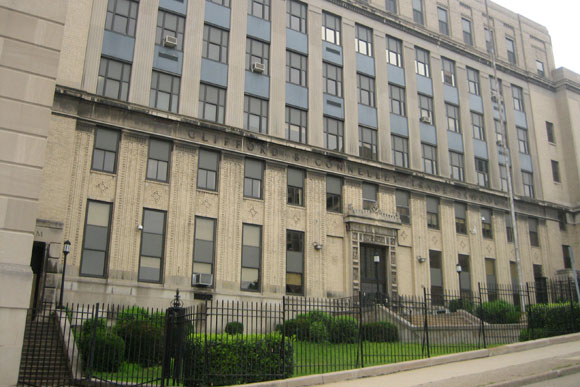
The former Clifford B. Connelley Vocational School will be converted into a green center for sustainable education.
State Senator Jim Ferlo and the board of Pittsburgh Green Innovators hosted tours of the former Clifford B. Connelley Vocational School last Thursday in the Hill District, in order to explain the progress that has taken place in their project to turn the former high school into a green center for sustainable education. The Connelley Project will be a major force in Pittsburgh’s movement towards green workforce development.
The Connelley project is organized by a partnership between Pittsburgh Green Innovators, and the developer Pittsburgh Gateways Incorporated, who are currently leasing the building from the school district. The school district had to shut it down in 2004 due to funding issues.
“The building purchase will be finalized in August, once the school board has finished moving all of its equipment out,” explains Deno de Ciantis, director of the Penn State Center, which plans to be an anchor program in the building.
After the purchase is made, the project will enter phase one of building construction. Both PGI and Green Innovators expect it should be completed by Fall of 2011. They intend to develop approximately 190,000 square feet of the facility’s 230,000 square feet.
“Capital fundraising efforts are on track. Upgrades to the building will include deep energy retrofits, the purchase of energy production equipment, and costs associated with LEED certification,” says Senator Ferlo.
Although a wide number of organizations have expressed interest in securing space at the building, de Ciantis says that leasing on spaces will not begin until after the purchase has been made. What de Ciantis and Ferlo are certain about, however, is that using the Connelley building to educate and train students and adults with the skills they need to excel in green job fields is critical to the growth of the green economy in Pittsburgh.
Writer: John Farley
Sources: Deno de Ciantis, Director of the Penn Center
Senator Jim FerloPhotograph Copyright John Farley
-
Brookline School’s Garden Nurtures Students’ Senses
By Jodi Weigand
PITTSBURGH TRIBUNE-REVIEW
Wednesday, June 16, 2010
Jimi Hutchin, 14, sings "God Bless America" with help from Pioneer chorus director Mark Kwolek during a tree-planting ceremony for the Brookline school's sensory garden on Tuesday. Sidney Davis | Tribune-Review
Pioneer school in Brookline on Tuesday formally dedicated one of the area’s first sensory gardens located at a public school.
The gardens provide people with intellectual and developmental disabilities a range of sounds, sights, textures and smells. Pioneer serves about 75 children and adults ages 5 to 21 with rare disabilities and special medical needs.
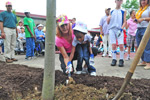
Pioneer school special-education teacher Mary Lou Walczak helps Cache Brown, 8, plant a tree for the school's sensory garden on Tuesday. Sidney Davis | Tribune-Review
“What an important prototype this is going to become for our entire region,” said Judy Wagner, senior director of the community garden and green space program for the Western Pennsylvania Conservancy, which helped design the garden. “This is a very special example of how greenery can really improve the lives of everyone.”
Pioneer’s garden, on about an acre of land in the school’s backyard, has textured plants and brightly colored, fragrant blooms. It features a fountain, hummingbird feeders, swings and benches. Still to be installed are vine canopies over some of the walkways, outdoor musical instruments and raised planters for students to use. A $100,000 grant from the Edith L. Tress Charitable Trust funded the gardens.
“Students will be able to grow fruits and vegetables, and we’ll harvest those for (a course called) activities of daily living, where they learn how to cook and shop and store food,” said Principal Sylbia Kunst. “Our teachers will develop lessons using different parts of the sensory garden.”
Chris Hutchin of Carrick said she’s glad her son Jimi, 14, who has attended the school since 2000, will get to spend more time outdoors.
“A big part of the kids’ growth is being outside,” she said.
When designing the garden, Pioneer officials and the architect sought input from organizations such as the Western Pennsylvania School for Blind Children and Allegheny Valley School, which both have sensory gardens.
“They can encourage imagination or stress release (or) if someone needs to have more stimulation because they’re lethargic,” said Carol Erzen, director of training and staff development at Allegheny Valley School, which provides therapeutic programs to adults and children with disabilities. “It’s a place to truly enjoy nature.”
Kunst said having a secure, handicapped accessible garden at Pioneer will provide more learning opportunities.
“This is another way for our kids to be involved,” she said.
-
Former School to Become Green Center
Friday, June 11, 2010By Diana Nelson Jones, Pittsburgh Post-Gazette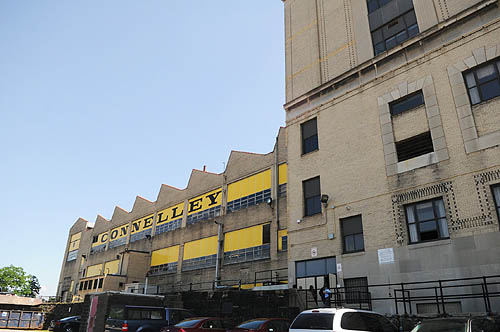
The old Connelly Technical Institute is planned to be used as a business incubator.
The 80-year-old former Connelley Technical Institute in the Hill District is slated to become a green technology demonstration showcase under the ownership of Pittsburgh Green Innovators Inc.
PGI has a sales agreement with Pittsburgh Public Schools and expects to close this summer and begin retooling the former vocational school by fall, said Deno DeCiantis, a PGI board member and director of the Penn State Center, an outreach service for Penn State University in Pittsburgh.

Now vacant, the fifth floor of the "Academic Tower" at the old Connelly Technical Institute contained a full-size commercial kitchen for its culinary students.
The Bedford Avenue school was closed in 2004. It has 220,000 square feet of space. When retrofitted, it will be loaded with green technology to demonstrate function and to absorb the building’s costs.
The prospective new owners envision the site as an incubator of green industry, a job training center for green-industry jobs and a technical support center for work force development.
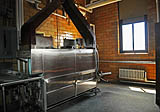
Now used as storage space, the fifth floor of the "Academic Tower" at the old Connelly Technical Institute previously served as a full-size commercial kitchen for its culinary students.
“There are so many jobs that will be created under the broad theme of energy independence,” said state Sen. Jim Ferlo, D-Highland Park, a PGI board member.
PGI is a collaboration of representatives from universities, labor unions, the Green Building Alliance, Hill House and a dozen other entities, plus Mr. Ferlo, state Rep. Jake Wheatley, D-Hill District, and U.S. Rep. Mike Doyle, D-Forest Hills.
Board members led two public tours of the building Thursday, from the spacious top floor with a view of the North Side to the darkened corridors lined with lockers to the ground floor of classrooms that are sky-lit by a sawtooth roof.
State grants of $4 million will enable the organization to create a geothermal pumping system that is expected to provide the building with 65 percent of the energy it will need, said Bill Miller of Pittsburgh Gateways, a nonprofit developer. The extension’s sawtooth roof — each panel of which slants toward the south — “is oriented perfectly for solar panels,” said Mr. DeCiantis.
“There’s nothing we’re doing that isn’t green” Mr. Miller said. Besides the geothermal system, he said, “the rest of our energy will come from solar, wind and microturbines fueled by different energy sources. We will do high-performance glazing, have a green roof, rain gardens and bioswales.”
Mr. DeCiantis said the first phase of retrofitting the building will be under way by fall.
The sales price will be about $200,000, Mr. Ferlo said, because PGI will take over the costs and burdens of remediation and rehabilitation that normally would be required of the seller.
The organization has raised $17 million from public and private donations toward an estimated $16.5 million for first-phase renovations, Mr. Miller said. The entire project will cost about $40 million, he said.
Two years ago, the initiative began establishing an alliance of unlikely collaborators: the Sierra Club, smart-growth advocates, labor leaders and academics.
Anchor tenants will be Penn State and the International Union of Operating Engineers Local 95.
When the project was in the early stage, founding board member Bernie Lynch said the organization’s goal “is to bring all these sectors together to make this an economic hotbed.”
-
Vacant Houses Spur Art Initiative in Wilkinsburg
Thursday, June 10, 2010By Deborah M. Todd, Pittsburgh Post-GazetteWhen Wilkinsburg artist Lazae LaSpina noticed bright neon swirls of abstract art decorating boards used to shutter the North Side’s vacant Garden Theater, she saw an opportunity to spruce up blighted properties in her own neighborhood.
“I could tell people cared about that area,” she said. “In Wilkinsburg, with all of the abandoned properties in that area, I thought that would be a good idea if we did something similar.”
Originally conceived as a small neighborhood project in May 2009, Ms. LaSpina’s idea has grown into a plan that will not only beautify the homes, but could potentially establish the community as a haven for artists. The Whitney Avenue Art Gallery “Houses in Waiting” project kicked off May 28 with a youth orientation event at Hosanna House.
Funded by the Wilkinsburg Weed and Seed, the Pennsylvania Council on the Arts, the Wilkinsburg Municipal Authority and the Wilkinsburg Development Authority, the project’s goal is to recruit community members to paint plywood window covers for 10 to 12 vacant houses on Whitney Avenue’s’s 700 block — transforming the space to what organizers call an “outdoor gallery.”
But if the idea catches on the way Ms. LaSpina and Wilkinsburg officials hope it will, the project will spearhead a push to promote the properties for sale as well as programs available for potential homeowners.
“The theme ‘Houses in Waiting’ intends the board-up art to act as a placeholder while interest is generated for a wide spectrum of home buyers to invest in the neighborhood and take advantage of Wilkinsburg’s ten-year property tax abatement program,” reads the WAAG web site.
The initiative also has potential to bring neighbors in the Hamnett Place community together to collaborate behind a common theme for the artwork. Volunteers are split up into youth and adult groups where professional artists help lead discussion and activities to determine themes.
Artist Ernest Bey, whose work includes elaborate wood carvings created for the Garden Dreams Nursery on Holland Avenue, said he looks forward to speaking to youth about the project.
“I want to challenge students, who are going to be becoming the lead artists on this project. I want their input,” he said. “Because when you involve young people, they come up with something you totally didn’t anticipate.”
Multimedia artist Kate Joranson said she will encourage adult volunteers to observe the environment around the houses to come up with ideas for themes.
“Boarded up buildings and abandoned sites can evoke a lot of emotion,” she said. “I want to try to collect those stories through writing, drawings, maybe collect small objects.”
With the window covers painted and primed, workshops scheduled throughout the month and a grand opening event scheduled for July, organizers are optimistic the initiative will help residents see the community in a new way.
Councilwoman Vanessa McCarthy-Johnson said she hopes the initiative can grow to include more of Ms. LaSpina’s ideas, such as artists in residence and community parties to promote the site. But she said the initial start is more than enough to spark additional improvements in the neighborhood.
“It gives a sense of value instead of devastation to the properties in the neighborhood. People will look at where they live a little different,” she said.
They’ll see its not just an abandoned house, it can be just about anything you want it to be.”
-
Students Pen a Historical Look at Homestead – Book Features Poems, Photos, Essays
Thursday, June 10, 2010By Dana Vogel, Pittsburgh Post-GazetteThanks to the Young Preservationists Association — a nonprofit organization that encourages the participation of young people in historic preservation — the history of Homestead has come alive for a group of Propel Andrew Street High School students.
The association’s Youth Main Street Advisers Program and seven students from Propel Andrew Street held a book signing last Thursday in Homestead to launch their new book, “Take a Walk From the Past to the Future of Eighth Avenue,” published by Red Engine Press.
The book was the result of a year-long project to better understand Homestead’s historic commercial district and to envision a new future.
“Take a Walk From the Past to the Future of Eighth Avenue,” which is divided into three parts representing the past, present and future of Eighth Avenue, features essays, poems and interviews by the students. The book also includes photographs of the neighborhood from the past and present.
Dan Holland, CEO of the youth group, explained the idea for a book came from a desire to do something more enduring than a video. “We wanted something you can see, feel, touch,” he said.
The rest of the story came down to a combination of luck and preparedness, Mr. Holland said. He explained that he ran into his longtime friend Jeremy Resnick, executive director and founder of Propel, at a barber shop and mentioned his idea. With a grant from the Grable Foundation and approval from Propel superintendent Carol Wooten, students from Propel Andrew Street in Munhall turned Mr. Holland’s dream into a reality.
The most significant result of the project seems to be its effect on the students.
Stephanie Nachemja-Bunton, a teacher at Propel Andrew Street and the group’s adviser, said, despite a few initial setbacks, “the seven students who completed the books were dedicated and did a wonderful job.”
She said that in addition to researching Homestead in books and on the Internet, the students took a number of tours of the borough.
Dr. Wooten said not only did the project give the students a stronger sense of community, but it also helped them to meet Pennsylvania academic standards, particularly in communications. She also emphasized that the group aspect of the project will help to prepare the students for the workplace.
The students also agreed that, in the end, the project was about learning.
“The experience was good. I gained knowledge and learned about the community,” said MalikQua Salter, a 17-year-old junior from Rankin, who contributed an essay, interview and photo essay to the book.
MalikQua, whose father grew up in Homestead, wrote in the book, “Eighth Avenue is no longer what it used to be, but many people are coming together to make it what it once was.”
Freshman Janiece Hall, 15, of Penn Hills, said, “I learned about interviewing and communication skills.”
Janiece, who has a poem, photo essay, interview and essay feature in the book, also said that while the project seemed difficult at first, “as it was coming together, it got easier.”
In her poem, she describes earlier excitement on the avenue which is “now as empty as a dried up river bed.”
The result of all the hard work seems well worth it to MalikQua. “The book turned out great. We worked hard and put in a lot of effort, and it’s pretty good,” she said.
Echoing her sentiments, Mr. Holland said: “I’m thrilled with the book. It’s a very compelling product.
“Our hope is that the community will embrace this book as well,” he added.
For a copy of “Take a Walk From the Past to the Future of Eighth Avenue,” call the Young Preservationists Association at 412-363-5964.
-
PHLF Awards Five Scholarships to College-Bound Students
Pittsburgh, PA…On June 16, during a luncheon celebration, the Pittsburgh History & Landmarks Foundation (PHLF) will award scholarships to five high-achieving college-bound students who are involved in their communities and value Pittsburgh’s history, architecture, and landscape design. PHLF received 47 applications this year and was able to award five scholarships, thanks to the continuing support of the Brashear Family Named Fund at PHLF and generous donations from others.
“Each year the Landmarks Scholarship Committee looks forward to reviewing all the applications,” said David Brashear, founder and chair of PHLF’s Scholarship Committee. “This program helps us connect with young people who share our values and who we believe will contribute to Pittsburgh during their lifetime.” The five scholarship recipients are:
Stephen R. Karas of Pittsburgh Schenley High School;
Victoria N. Lewis of Woodland Hills High School;
Anna M. Murnane of Woodland Hills High School;
Candice L. Thornton of Sto-Rox Sr./Jr. High School; and
Eric C. Wise of South Fayette High School.Each scholarship, for book and tuition expenses only, has a maximum value of $4,000, and is made payable to the recipient’s college/university over a four-year period. “The Landmarks Scholarship Program is helping our organization build relationships with capable young people who value Pittsburgh’s history, architecture, and landscape design,” said Louise Sturgess, Executive Director of PHLF. “It is the culmination of our educational programs for thousands of students (K-12) in Pittsburgh and Allegheny County and gives students an incentive to excel in school, become involved in their communities, and explore their city in a meaningful way.”
Since 1999, PHLF has granted 40 scholarships to a remarkable group of young people. Nineteen students are Pittsburgh Public School graduates and 21 are graduates from other schools within Allegheny County. Twenty winners have already graduated from various colleges/universities, and 14 of those people still have a home base in Pittsburgh: several work as architects and engineers, one teaches at CMU, one works at UPMC, and another inspects bridges.
The Pittsburgh History & Landmarks Foundation Scholarship Program is offered each year. Applications for the 2010-11 school year will be available in Jan. 2011. Applicants must:
- live in Allegheny County;
- be a high school senior who has been accepted to a college or university;
- have a cumulative Grade Point Average at the end of the first semester senior year
- of 3.25 or greater; and
- write an essay on a certain topic, complete an application, and submit two letters of recommendation.
2010 Landmarks Scholarship Recipients: Student Profiles
Stephen R. Karas
A graduate of Pittsburgh Schenley High School, Stephen Karas will be attending Penn State University to study Mechanical Engineering.
Stephen is an Eagle Scout and the recipient of the Kiwanis Club of Sheraden scholarship. At Schenley, he helped his Think-A-Thon team win an Overall Grand Champions award in 2009. He also was a member of the 2009 Soccer City Championship team and a member of the Volleyball City Championship teams in 2007, 2008, and 2009. Stephen has worked as a lifeguard for the City of Pittsburgh and as a soccer coach for the Special Olympics; he is a driver for Meals on Wheels and a member of his church choir.
In his scholarship essay Stephen wrote that “the memories that I have of the Ascension Church [in Sheraden] are powerful ones and will stay with me. This building . . . still touches the lives of the people in the community . . . I believe that the architectural history of the building is very representative of Pittsburgh as a whole. It is a humble structure, whose constituents are friendly and hardworking individuals. Its history is an interesting one and important lessons can be learned from it. Through hard work and change, beautiful things can come forth.”
Victoria N. Lewis
A graduate of Woodland Hills High School, Victoria Lewis will be attending Howard University to study Architecture. Victoria is a member of the National Honor Society and was recognized by State Representative Paul Costa for excellence in academics, leadership, and community service. At Woodland Hills, she was a member of the high school track and field team. Her Gymkhana Gymnastics team won the 2008 and 2009 State Gymnastics Championships. As a member of Urban Youth Action, Inc., Victoria has participated in annual Thanksgiving food drives and community clean-ups. She is a member of Deliverance Baptist Church and has worked at BNY Mellon and Gwen’s Girls, Inc.
In her scholarship essay Victoria describes her sense of awe over downtown Pittsburgh: “When I took the Pittsburgh city tour with my class in grade school I learned the importance of the designs on the Smithfield Street Bridge and the meaning of many inconspicuous designs on the buildings throughout downtown. After the tour I looked at my city with pride. . . .
“I made a decision to study architecture at Howard University. After talking with the dean of the school of architecture, imagine my surprise when I learned that all domestic travel to study architecture in the college is done in Pittsburgh and the surrounding area. . . .
“Pittsburgh is unique because it has been successful in preserving the beauty of many historical structures while weaving them together with modern architectural designs.”
Anna M. Murnane
Also a graduate of Woodland Hills High School, Anna Murnane will be attending Syracuse University to study Architecture.
Anna is a member of the National Honor Society and was on the Woodland Hills varsity cross country team. She has performed with the Woodland Hills Orchestra, Marching Band, and Fine Fiddlers of Pittsburgh, where she also has volunteered. Anna has worked as a camp counselor and has attended pre-college art/architecture programs at Carnegie Mellon and Drexel universities.
In her scholarship essay Anna wrote: “Pittsburgh is my birthplace, so it is a city I have taken for granted for most of my life. In my sophomore year of high school I had the opportunity . . . to . . . participate in the Architecture Apprenticeship offered by the Pittsburgh History & Landmarks Foundation. My interest was driven by my desire to learn more about a career that would combine my artistic talents with my interest in math and physics. What I did not expect was that it would open my eyes to the beauty and history offered by Pittsburgh, and provide a direction and vision for my future.”
Candice L. Thornton
A graduate of Sto-Rox Sr./Jr. High School, Candice Thornton will be attending The College of Wooster to study Chemistry and Archaeology.
Candice was a Student Ambassador for Sto-Rox High School and a member of the marching band, concert band, and chorus. She was manager of the volleyball team, editor-in-chief of the newspaper, peer tutor, and a team leader for Environmental Journalism, among other activities. Candice also was a member of the National Honor Society and Student Government. She has volunteered for Meals on Wheels, the McKees Rocks Community Development Group, and at a nursing home.
In her scholarship essay Candice wrote, “As a third grader I rode the Duquesne Incline to Mt. Washington for a field trip. When I saw the view of Pittsburgh from the overlook I was completely astounded, so much so that I leaned too far over the edge and lost my glasses. My mind was rattled by the sight of the Pittsburgh Golden Triangle and the convergence of the rivers. . . . Pittsburgh’s history and architecture are a part of my heritage. Growing up in the Pittsburgh region has given me much to be proud of and imbued in me many values such as: perseverance, diligence, character, pride, and a strong sense of self. . . .
“My grandfather was a craftsman . . .
“My father was an iron worker . . .
“I am a student of Pittsburgh’s history. It teaches me life lessons and values about hard work and determination. I am an admirer of Pittsburgh’s architecture. . . . To me the landscape, history, and architecture of Pittsburgh are my heritage.”
Eric C. Wise
A graduate of South Fayette High School, Eric Wise will be attending Carnegie Mellon University to study Mechanical and Biomedical Engineering.
Eric was South Fayette’s Valedictorian, a Westinghouse Science Honors Institute exam winner, and an AP Scholar with Distinction. He was selected as a gold medalist from among the Pittsburgh Tribune-Review’s “Outstanding Young Citizens” and was included in NEXT Magazine’s top 25 young men in Pennsylvania for service to school and community. Eric performed in South Fayette’s Marching and Concert Bands, and participated in the Future Business Leaders of America and in the National Economics Challenge, among many other activities.
In his scholarship essay Eric wrote: “Schenley Park in Oakland contains the components that contribute to making a place significant. It is rich in landscape design with its many trails, ice skating rink, and golf course. Its layout highlights nearby architectural treasures like Phipps Conservatory and the many museums of Oakland. These gems of culture, history, science, and the arts are what make Pittsburgh a treasure for me and all of its citizens.”
________________________________________________________________
Founded in 1964, the Pittsburgh History & Landmarks Foundation is a non-profit membership organization working to: identify and save historically-significant places; revitalize historic neighborhoods, towns, and urban areas; preserve historic farms and historic designed landscapes; and educate people about the Pittsburgh region’s rich architectural heritage. www.phlf.org.


